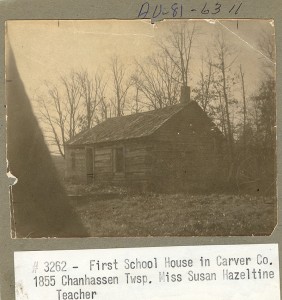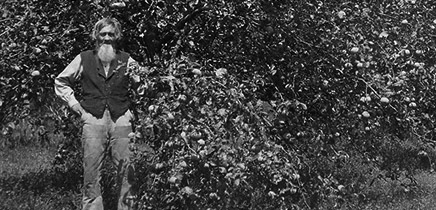Early schools in Minnesota were a curious mix of public and private. Schools were small then, and often held in the same building as the church or town meeting hall. Many schools had ties to local churches, and were what we would consider religious schools. Pioneer families with little money often only owned one book, a bible, which was used in school studies. The schools were public in being open to all, and having the support of the state for money, supplies, and testing, to name a few things. In the twenty-first century, schools are not allowed ties to a specific religion unless they are a private institution.
In the twenty-first century, private schools continue to provide religiously based education, though some private schools have no ties to a church or religion. Carver County is home to four school districts. There are many private schools that fall within the boundaries of these four school districts, each with its own goals, strengths, and educational approach. Overall, private education has remained much the same as it was in one-room schoolhouse days, focusing not only on basic lessons like reading, but also religious and moral lessons. They only major change, besides changing punishments and lessons, has been the size of these schools, though they remain small relative to public schools.
Independent School District #108 is based out of Norwood Young America (NYA). The boundaries of this school district hold the Emanuel Lutheran School of Hamburg (1857), St. John’s Lutheran School of Norwood Young America , and Zion Lutheran School and St. Bernard’s Catholic School (1856) of Cologne. St. Bernard’s is one of the very few Catholic schools in this county. Each of these schools covers elementary grades, from preschool to sixth or eighth grade. Each of these schools is also small enough that the grades are combined in classes, like grades one and two together or grades three and four.
Waconia Independent School District #110 is based out of Waconia. This district’s boundaries hold St. Joseph’s Catholic School (1860) and Trinity Lutheran School, both of Waconia and St. Marks Lutheran School of New Germany (1914). Each of these schools covers elementary grades, from preschool to sixth or eighth grade. St. Joseph’s has the claim of being the first school in what was then the village of Waconia.
Watertown-Mayer Independent School District #111 is based out of Watertown. Within its boundaries are Zion Lutheran School (1905) and the Lutheran High School (1961) of Mayer, and Christ Community Lutheran School of Watertown, which has ties to both St. Paul’s and St. Peter’s Churches. All serve pre-school to eighth grade save for Mayer Lutheran High School. Mayer Lutheran High serves student from every corner of the county and beyond. It is one of only three private highschools in the county. Christ Community Lutheran School was formerly known as the St. Peter’s St. Paul’s school.
The final district is Independent School District #112, Eastern Carver County Schools. Covering Chaska, Chanhassen, East Union, New Germany and Victoria, the boundaries of this district are broad. Private schools within this district include Chapel Hill Academy (1970) and St. Hubert’s Catholic School (1865) of Chanhassen; SW Christian High School (1996), Guardian Angels Catholic School (1858), St. John’s Lutheran School (1886), Jonathan Montessori (1972) and the World Learners School (1990), Step by Step Montessori, and the Minnesota Valley Baptist School of Chaska; and Holy Family Catholic (2000) of Victoria. All of these school serve preschool to grade eight. The exceptions are Jonathan Montessori which is preschool only, Step by Step Montessori which is kindergarten and younger, Minnesota Valley Baptist which is kindergarten through grade eleven, and the two highschools- Holy Family Catholic and SW Christian. Jonathan Montessori and the World Learners School fall under their own district, ISD #4016, even though located within District #112 boundaries. The Minnesota Valley Baptist School serves the smallest student body, with ten students. This district serves much larger students bodies than in the private schools of any other district, and also boasts the newest private schools from around the county. A new private school was designate on the grounds of the University of Minnesota Landscape Arboretum in 2013 as well.
Turning Point: Private education has remained much the same as it was in one-room schoolhouse days, focusing not only on basic lessons like reading, but also religious and moral lessons, though the size of the schools and classes have grown.
Chronology:
- 1855: The first schoolhouse in Carver County, taught by Susan Hazeltine.
- 1856: The first School district in Carver County is Minnesota School District #1 in Carver.
- 1856: St. Bernard’s Catholic Community in Cologne is founded.
- 1857: Carver County has five school districts, which are Chaska, Chanhassen, Benton, Groveland, and Carver.
- 1857: Emanuel Lutheran School of Hamburg is founded.
- 1858: Guardian Angels Catholic school in Chaska is founded.
- 1860: St. Joseph’s Catholic School of Waconia is founded.
- 1865: St. Hubert’s Catholic Community in Chanhassen is founded.
- 1886: St. John’s Lutheran School of Chaska is founded.
- 1905: Zion Lutheran School of Mayer is founded.
- 1914: St. Mark’s Lutheran School of New Germany is founded.
- 1950s-1971: School districts across Carver County and Minnesota consolidate into fewer school districts, each covering a larger area.
- 1961: Mayer Lutheran High School is founded.
- Late 1960s-1971: District #110 as it is now is consolidated.
- 1970: Chapel Hill Academy in Chanhassen is founded.
- 1971: Watertown and Mayer schools combine to form District #111, Watertown-Mayer School District.
- July 1, 1971: District #112 is consolidated into its current boundaries.
- 1972: Jonathan Montessori in Chaska is founded.
- 1990: World Learners School of Chaska is founded.
- 1996: Southwest Christian High school in Chaska is founded.
- 2000: Holy Family Catholic High school opens its doors.

Bibliography:
Chapel Hill Academy website. Accessed March 3, 2013. http://www.chapel-hill.org/
Christ Community Lutheran School website. Accessed March 3, 2013. http://www.ccls.net/
Emanuel Lutheran Church and School website. Accessed March 3, 2013. http://www.elchamburg.org/
Guardian Angels Catholic Community website. Accessed March 3, 2013. http://www.gachaska.org/Welcome.html
Hartley, Lucie. “History of School District 112”. District 112 archives. Chaska, 1975.
Hoffman, Colleen. District #111 office. E-mail message to author, February 25, 2013.
Holy Family Catholic High school website. Our History. Accessed March 3, 2013. http://www.hfchs.org/ourhistory.php
Independent School District #108, Central School District website. Accessed March 3, 2013. http://raiders.central.k12.mn.us/isd108/
Independent School District #110, Waconia School District website. Accessed March 3, 2013. http://www.waconia.new.rschooltoday.com/
Independent School District #111, Watertown-Mayer Schools website. Accessed March 3, 2013. http://www.wm.k12.mn.us/se3bin/clientschool.cgi?schoolname=school274
Independent School District #112, Eastern Carver County Schools website. Accessed March 3, 2013. http://www.chaska.k12.mn.us/welcome.html
Johnson, Brett. District #112 office, Director of Communications and Community Relations. E-mail message to author, February 25, 2013 and February 26, 2013.
Jonathan Montessori School website. Accessed March 3, 2013. http://jonathanmontessori.com/
Jonathan Montessori World Learners School website. Jonathan Montessori History. Accessed March 3, 2013. http://jonathanmontessori.com/whyjonathanmontessori/history.html
Killian, Jessica. District #110 office. E-mail message to author, February 26, 2013.
“One-Room school house”. Educational program. Carver County Historical Society.
Private School Review website. Minnesota Valley Baptist School. Accessed March 3, 2013. http://www.privateschoolreview.com/school_ov/school_id/14910
Mayer Lutheran High School website. Accessed March 3, 2013. http://lhsmayer.org/
Southwest Christian High school website. History. Accessed March 3, 2013. http://swchs.org/index.php?option=com_content&view=article&id=127&Itemid=223
St. Bernard’s Catholic Community website. Accessed March 3, 2013. http://st-bernard-cologne.org/
St. Hubert’s Catholic School website. School History. Accessed March 3, 2013. http://school.sthubert.org/school/school-history.php
St. John’s Lutheran School website. Accessed March 3, 2013. http://stjohnsnya.weebly.com/index.html
St. John’s Lutheran School website. About Our School. Accessed March 3, 2013. http://www.sjschaska.org/page/about_our_school
St. Joseph’s Catholic School website. Our History. Accessed March 3, 2013. http://www.stjosephwaconia.org/school/index.cfm?load=page&page=152
St. Mark’s Lutheran Church and School FaceBook page. Accessed March 3, 2013. https://www.facebook.com/pages/St-Mark-Lutheran-Church-New-Germany-MN/235493589847302?id=235493589847302&sk=info
Step by Step Montessori website. Accessed March 3, 2013. http://stepbystepmontessori.com/
Trinity Lutheran Church and School website. Accessed March 3, 2013. http://www.trinitywaconia.org/index.html
World Learners School website. Accessed March 3, 2013. http://www.worldlearnerschool.com/
Zion Lutheran Church and School website. Accessed March 3, 2013. http://zioncologne.wix.com/zion-lutheran-church-school#!
Zion Lutheran School website. School History. Accessed March 3, 2013. http://www.zionmayer.org/school/schoolhist.htm
Related Resources:
[Primary]
[Secondary]
Barac, Lavonne. Chaska:A Minnesota River City, Volume 1 and 2. St. Paul, MN: Carver County Public Library, 1989.
Carver County: Today and Yesterday. Compiled by the Carver County Statehood Centennial Committee, 1958.
Centennial Book Committee. MayerCenntennial, 1886-1986. Mayer, MN: 1986.
Centennial Committee. New Germany Centennial Book, 1887-1987. New Germany, MN: 1987.
Erickson, Lynne Martin and Kathryn Leide. “Bi-Folkal Kit: Remembering School Days, Lessons”. Hennepin County Library. Madison, WI: Bi-Folkal Productions, Inc.
Fisher, Leonard Everett. Schools: 19th Century America Schools (Nineteenth Century America Series). New York: Holiday House, 1983.
Fuller, Wayne Edison. One-Room Schools of the Middle West: An Illustrated History. Lawrence, KS: University Press of Kansas, 1994.
Hoisington, Daniel John. Chanhassen: A Centennial History. Chanhassen, MN: The Press, Banta Corporation, July 1996.
Holcombe, Maj. R.I., editor. Compendium of History and Biography of Carver and Hennepin Counties, Minnesota. Henry Taylor and Company: Chicago, 1915.
Johnson, Charlotte Mary Speikers Christensen. The History of the Watertown, Minnesota Area 1856 to 2006: 150 Years of Community Life. Watertown, MN: 2006.
“Life in Carver County.” Carver County Citizen. 7 no. 2 (December 2006): 1-4.
Loeper, John J. Going to School in 1876. New York: Atheneum, 1984.
Mayer Booster Club. History of Helvetia-Mayer and Community. Lester Prairie, MN: Lester Prairie News, 1936.
Norwood Book Committee. Norwood Centennial, 1872-1972. Glencoe, MN: Kopy Kat Printing, 1972.
Olson, Steve. Cologne: the first 100 years. Cologne, MN: 1981.
Smetana, Mary. “Recalling one-room schools”. Carver County News, December 10, 1987.
Theen, Olive Ireland. Country School Days: The Vanished One Room School. St. Cloud, MN: Sentinel Print, Co., 1992.
Theobald, Paul. Call School: Rural Education in the Midwest to 1918. Carbondale, Ill.: Southern Illinois University Press, 1995.
Tremblay, Ruth and Lois Schulstad. Images of America: Carver County. Arcadia Publishing: Charleston, South Carolina, 2011.
Warner, George E. and Charles M. Foote. History of the Minnesota Valley: Carver County. Minneapolis: North Star Publishing Company, 1882. Republished 1986.
Watertown Centennial: 1856 . . .1956. Watertown, MN: Watertown Activities, Inc., 1956.
[Web]
Images/Audio/Video
AV-81-6311. Photograph Collection, Carver County Historical Society, Waconia. Photographic print “First Schoolhouse in Carver Co.” [Description]: First Schoolhouse in Carver Co. (as seen in) 1855 Chanhassen Twsp. Miss Susan Hazeltine Teacher. Rights held by the CCHS.
“This article used with the permission of MNopedia, operated by the Minnesota Historical Society, under a Creative Commons License. No changes have been made to the article’s content.”


